
A gemstone is a piece of mineral crystal which, when cut or polished, is used to make jewelry or other adornments. Certain rocks and occasionally organic materials that are not minerals may also be used for jewelry and are therefore often considered to be gemstones as well. Most gemstones are hard, but some softer minerals such as brazilianite may be used in jewelry because of their color or luster or other physical properties that have aesthetic value. However, generally speaking, soft minerals are not typically used as gemstones by virtue of their brittleness and lack of durability.

Sapphire is a precious gemstone, a variety of the mineral corundum, consisting of aluminium oxide (α-Al2O3) with trace amounts of elements such as iron, titanium, cobalt, lead, chromium, vanadium, magnesium, boron, and silicon. The name sapphire is derived from the Latin word sapphirus, itself from the Greek word sappheiros (σάπφειρος), which referred to lapis lazuli. It is typically blue, but natural "fancy" sapphires also occur in yellow, purple, orange, and green colors; "parti sapphires" show two or more colors. Red corundum stones also occur, but are called rubies rather than sapphires. Pink-colored corundum may be classified either as ruby or sapphire depending on the locale. Commonly, natural sapphires are cut and polished into gemstones and worn in jewelry. They also may be created synthetically in laboratories for industrial or decorative purposes in large crystal boules. Because of the remarkable hardness of sapphires – 9 on the Mohs scale (the third-hardest mineral, after diamond at 10 and moissanite at 9.5) – sapphires are also used in some non-ornamental applications, such as infrared optical components, high-durability windows, wristwatch crystals and movement bearings, and very thin electronic wafers, which are used as the insulating substrates of special-purpose solid-state electronics such as integrated circuits and GaN-based blue LEDs. Sapphire is the birthstone for September and the gem of the 45th anniversary. A sapphire jubilee occurs after 65 years.

Ruby is a pinkish red to blood-red colored gemstone, a variety of the mineral corundum. Ruby is one of the most popular traditional jewelry gems and is very durable. Other varieties of gem-quality corundum are called sapphires. Ruby is one of the traditional cardinal gems, alongside amethyst, sapphire, emerald, and diamond. The word ruby comes from ruber, Latin for red. The color of a ruby is due to the element chromium.
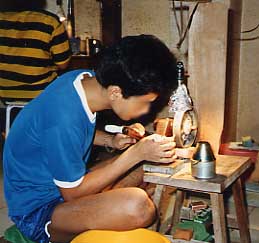
Lapidary is the practice of shaping stone, minerals, or gemstones into decorative items such as cabochons, engraved gems, and faceted designs. A person who practices lapidary is known as a lapidarist. A lapidarist uses the lapidary techniques of cutting, grinding, and polishing. Hardstone carving requires specialized carving techniques.
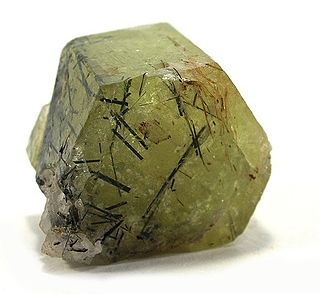
In mineralogy, an inclusion is any material trapped inside a mineral during its formation. In gemology, it is an object enclosed within a gemstone or reaching its surface from the interior. According to James Hutton's law of inclusions, fragments included in a host rock are older than the host rock itself.

Pokémon Pinball: Ruby & Sapphire is a 2003 pinball game developed by Jupiter and published by The Pokémon Company and Nintendo for the Game Boy Advance handheld game console. It was first revealed at E3 2003. The North American release was done to coincide with the fifth anniversary of the North American release of Pokémon Red and Blue. It is based on Pokémon Ruby and Sapphire, and is a sequel to Pokémon Pinball for the Game Boy Color. In some ways, it plays like a traditional pinball game, where the objective is to get a high score by keeping the ball in play as long as possible and hitting bumpers. In keeping with the theme of Pokémon, it features Pokémon collection, where while the players play pinball, they must also capture the eponymous creatures.
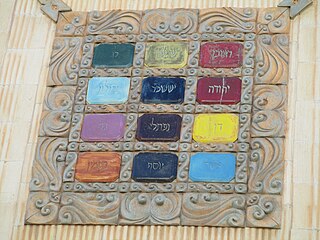
The priestly breastplate or breastpiece of judgment was a sacred breastplate worn by the High Priest of the Israelites, according to the Book of Exodus. In the biblical account, the breastplate is termed the breastplate of judgment, because the Urim and Thummim were placed upon it. These elements of the breastplate are said in the Exodus verse to carry the judgment of God concerning the Israelites at all times.

Tairus is a synthetic gemstone manufacturer. It was formed in 1989 as part of Mikhail Gorbachev's perestroika initiative to establish a joint venture between the Russian Academy of Sciences and Tairus Created Gems Co Ltd. of Bangkok, Thailand. Today Tairus is a major supplier of hydrothermally grown gemstones to the jewellery industry. Later, Tairus became a privately held enterprise, operating out of its Bangkok distribution hub under the trade name Tairus, owned by Tairus Created Gems Co Ltd. of Bangkok, Thailand.

The Verneuil method, also called flame fusion, was the first commercially successful method of manufacturing synthetic gemstones, developed in the late 1883 by the French chemist Auguste Verneuil. It is primarily used to produce the ruby, sapphire and padparadscha varieties of corundum, as well as the diamond simulants rutile, strontium titanate and spinel. The principle of the process involves melting a finely powdered substance using an oxyhydrogen flame, and crystallising the melted droplets into a boule. The process is considered to be the founding step of modern industrial crystal growth technology, and remains in wide use to this day.

Navaratna is a Sanskrit compound word meaning "nine gems" or "ratnas". Jewellery created in this style has important cultural significance in many southern, and south-eastern Asian cultures as a symbol of wealth, and status, and is claimed to yield talismanic benefits towards health and well-being. The setting of the stones is believed to hold mystical powers tied to the astrology and mythology of Hinduism, Jainism, and Buddhism. The historic origin of the navaratna is tied to the astrological concept of "Navagrahas", or "nine celestial gods" (planets).

Vegas Showdown is a board game published by Avalon Hill in 2005 in which players compete to build the most impressive hotel and casino in Las Vegas. It was named "Game of the Year" by Games Magazine in 2007.
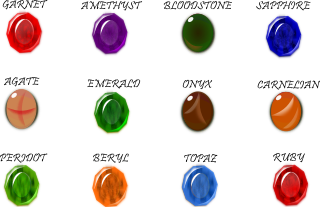
A birthstone is a gemstone that represents a person's birth period, usually the month or zodiac sign. Birthstones are often worn as jewelry or a pendant necklace.
A range of gemstones are mentioned in the Bible, particularly in the Old Testament and the Book of Revelation. Much has been written about the precise identification of these stones, although largely speculative.

Onyx is a two-player abstract strategy board game invented by Larry Back in 1995. The game features a rule for performing captures, making Onyx unique among connection games.

A lapidary is a text in verse or prose, often a whole book, that describes the physical properties and metaphysical virtues of precious and semi-precious stones, that is to say, a work on gemology. It was frequently used as a medical textbook since it also comprises practical information about the alleged medical application of each stone. Several lapidaries also provide information about countries or regions where some rocks were thought to originate, and others speculate about the natural forces in control of their formation.

Splendor is a multiplayer card-based board game, designed by Marc André and illustrated by Pascal Quidault. It was published in 2014 by Space Cowboys (Asmodee). Players are gem merchants of the Renaissance, developing gem mines, transportation, and shops to accumulate prestige points. Splendor received positive reviews and received numerous awards, including winner of Golden Geek Best Family Board Game. It was nominated for the Spiel des Jahres Game of the Year in 2014. The game also received a mobile application and an expansion released in 2017.
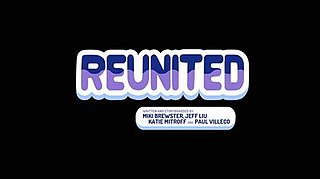
"Reunited" is the 23rd and 24th episode of the fifth season of the American animated television series Steven Universe, and the 151st and 152nd episode of the series overall. A 22-minute double-length special episode, it was directed by Joe Johnston and Liz Artinian, and written and storyboarded by Miki Brewster, Jeff Liu, Katie Mitroff and Paul Villeco from a story by Johnston, Matt Burnett, Ben Levin, Kat Morris, Tom Herpich and series creator Rebecca Sugar. It first aired on July 6, 2018 as the final part of the seventh "StevenBomb", a series of six episodes aired between July 2 and 6.
FURA Gems is a private global mining company that produces colored gemstones: emeralds, rubies, and sapphires. Founded in 2017 FURA has its headquarters in Dubai, United Arab Emirates, and operates mining subsidiaries in Colombia, Mozambique, and Australia. In 2021, the company managed approximately six million carats of Mozambican rubies and 300,000 carats of Colombian emeralds. In 2022, FURA Gems unveiled the world's largest gem-quality ruby ever mined, which was sold by Sotheby's for $34.8 million in 2023.















